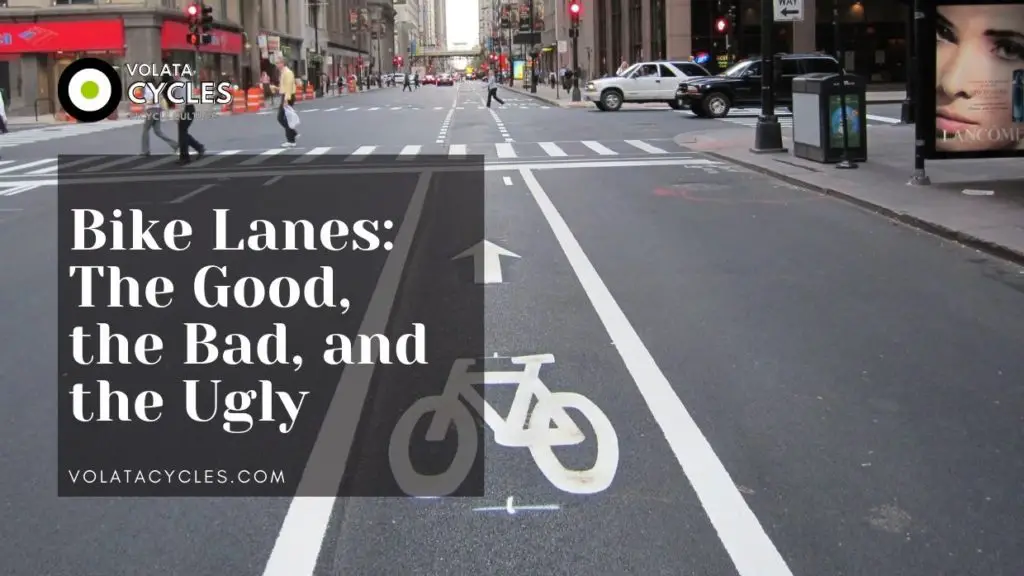The effects of a bike crash will reach all aspects of your life. Crashes can affect how you feel, reduce your enjoyment of life, and add financial strain on your wallet when you have to pay medical bills or cannot work.

For or Against Bike Lanes
Many cycling advocates support bicycle lanes, but some people oppose them. Those who oppose claim bike lanes only protect cyclists from rear-end collisions, which are the rarest type of collision. They also report an increased likelihood of collisions at intersections.
In theory, giving cyclists a dedicated space to safely share the road with vehicles is a good idea. However, bike lanes don’t always make cyclists safer. Some bike lanes offer no protection to cyclists at all. In fact, they may actually increase the risk of certain types of crashes.
The most common type of bike crash is a “dooring” collision. This happens when a driver or passenger opens their door into the path of a cyclist. These types of collisions usually happen when there is no bike lane present. Cyclists are forced to ride close to parked cars, making them more vulnerable to being “doored.”
Another type of collision that often occurs is the “right hook.” This happens when a driver turns right into the path of an oncoming cyclist. This type of collision can occur with or without a bike lane present. However, it is more likely to occur when there is no bike lane because cyclists are more likely to be riding in the middle of the lane. This makes it more difficult for drivers to see them.
The solution to making bicycle lanes safer is not to remove them. The solution is to redesign them so they are truly safe for cyclists. Bicycle lanes should be designed with doorings and right hooks in mind. They should be wide enough so that cyclists are not forced to ride close to parked cars. And they should have physical barriers, such as concrete curbs, to prevent drivers from turning into them.
Bike Lane Accident Data
According to data compiled by The New York Times, 28 cyclists in New York City were killed in accidents in 2019. This was a significant increase from prior years. Unsurprisingly, careless driving was the most common cause of accidents involving cyclists.
Many cyclists argue that changes at dicey intersections to give pedestrians more time to cross contribute to the issue. It’s important to remember that if you’re involved in a bike crash, you should consider contacting a bicycle accident attorney.
Bicycle Accident Claims
Getting the right information when you’re involved in an accident is important. A bicycle accident lawyer can help you understand how long you have to take legal action after a bicycle accident, what type of compensation you can seek, and the value of your claim. An attorney can also answer questions on fault.
In many states, including Illinois, you generally have two years from the date of your bicycle accident to take legal action. Sometimes, you only have one year if the at-fault party is a state entity or local municipality, such as a city, town, or village. Building your case takes time. A lawyer can help gather evidence, review documents, interview witnesses, and consult with experts. All of this needs to be done before the statute of limitations expires.
The type of compensation you can seek depends on the severity of your injuries and the damages you’ve incurred. You may be able to seek economic damages, such as medical bills, lost wages, and property damage. You may also be able to seek non-economic damages, such as pain and suffering, emotional distress, and loss of enjoyment of life. In some cases, you may be able to seek punitive damages. These are designed to punish the at-fault party for their actions.
The value of your claim depends on many factors, including the severity of your injuries, the number of economic damages you’ve incurred, the amount of non-economic damages you’ve incurred, the state in which you live, and the at-fault party’s insurance policy. A lawyer can help you understand the value of your claim and what you can expect
Bicycle Accident Damages
If you’re injured in a bicycle lane accident because of another’s negligence, you can seek compensation for both economic and non-economic damages. Economic damages are those that can be measured, whereas non-economic damages are more subjective losses.
Every case is different. It’s not always easy to determine the value of your personal injury accident claim. The value of a personal injury case depends on your injuries, medical bills, your lost wages, how your life was affected, the insurance coverage available, and the circumstances surrounding the accident.
Determining Fault In A Bicycle Lane Accident
Bicyclists have rights and legal responsibilities. They are also required to follow the road rules and can be deemed liable if an accident occurs when negligent. This means that the cyclist can be found at fault for causing an accident.
Contributory negligence means that cyclists can be held partially or fully liable in court. That’s why it is imperative to work with someone who understands the rights and responsibilities of bicyclists.
Pros and Cons For Bike Lanes
There are many benefits and drawbacks to using bike lanes.
Bicycle Universe data shows that separated bike lanes (with a physical barrier) cut the accident risk in half on high-speed roads (45 mph). The American Journal of Public Health reports that dedicated bike lanes cut injury risk by 90%.
Studies also demonstrate bike lanes improve safety for motorists because drivers passing cyclists veer farther left into opposing traffic without a dedicated bike lane.
Bike lanes promote safety for cyclists as they have more space than on unmarked roads. Some data shows that painted bike lanes offer little benefit on urban roads (30-45mph) and are more dangerous on low-speed roads (12/20mph) than no bike lanes.
When cyclists and drivers share lanes, the driver is required to perform an overtaking maneuver. Also, cyclists fear striking an opening car door. There’s the potential that bike riders might position themselves away from parked cars when riding in an on-road bicycle lane. As a result, they might ride in the door zone of parked cars.
The Dutch Reach method can help alleviate this fear and prevent dooring accidents. The technique involves opening your car door with the hand furthest away from the door handle. Doing so forces you to twist your torso and check for approaching traffic over your shoulder, making it less likely that you’ll open your door into the path of an oncoming cyclist.
Bike lanes can also make it more difficult for drivers to see cyclists at night. This is especially true when there are no reflectors or lights on the bike lane.
Bicycle lanes can also pose a problem for turning vehicles. In some instances, a car making a right turn might have to cross a bike lane. If there’s oncoming traffic, the driver might not be able to complete the turn safely.
Bicycle Statutes and Laws
Many statutes cover bicycle lanes that protect drivers and cyclists. Here are some of the most common laws to keep in mind after a bicycle accident:
- A vehicle’s door on the side available to moving traffic shall not be opened except when it is safe to do so.
- A bicycle is defined as any device propelled by human power upon which any person may ride, having two tandem wheels except scooters and similar devices.
- All of the rights and responsibilities usually granted to drivers of automobiles shall apply to bicyclists on highways.
- No bicycle shall be used to carry more persons at one time than the number for which it is designed and equipped.
- No bicycle, coaster, roller skates, sled, or toy vehicle shall be attached to a motor vehicle on a roadway.
- A bicycle operator may not carry any package, bundle, or item that prevents both hands from being used in the bike’s control and operation.
- A person operating a bicycle shall always keep at least one hand on the handlebars.
- A bicyclist who is riding on and along a sidewalk or across a street or road upon and along a crosswalk shall yield the right-of-way to any pedestrian and must provide an audible warning before passing such person.
Not following bicycle ordinances could lead to an accident. Speak with a bicycle accident attorney if you have been involved in an accident.
